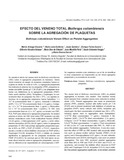Mostrar el registro sencillo del ítem
Efecto del veneno total bothrops colombiensis sobre la agregación de plaquetas
| dc.rights.license | http://creativecommons.org/licenses/by-nc-sa/3.0/ve/ | |
| dc.contributor.author | Arteaga Vizcaíno, Melvis | |
| dc.contributor.author | León Gutiérrez, Mario | |
| dc.contributor.author | Quintero, Jesús | |
| dc.contributor.author | Torres Guerra, Enrique | |
| dc.contributor.author | Vizcaíno, Gilberto | |
| dc.contributor.author | Diez de Edwald, María | |
| dc.contributor.author | Montilla F., Juan R. | |
| dc.contributor.author | Urdaneta V., Saulo H. | |
| dc.contributor.author | Álvarez García, María | |
| dc.date.accessioned | 2012-01-13T10:13:47Z | |
| dc.date.available | 2012-01-13T10:13:47Z | |
| dc.date.issued | 2012-01-13T10:13:47Z | |
| dc.identifier.issn | 0798-2259 | es_VE |
| dc.identifier.uri | http://www.saber.ula.ve/handle/123456789/34378 | |
| dc.description.abstract | Se estudió el efecto del veneno total de Bothrops colombiensis (VBC) sobre la agregación plaquetaria en humanos. Ciento veinte muestras de sangre de donantes voluntarios fueron recogidas en citrato de sodio al 3,8%. La agregación plaquetaria fue realizada en plasma rico en plaquetas (PRP), plaquetas lavadas con buffer tyrode pH 7,35 (PLBT) y en plaquetas incubadas con inhibidores de la agregación plaquetaria (PIAP): Acido acetil salicílico (ASA), Ticlopidina y Clopidogrel; la concentración final de plaquetas fue 250 x 109/L. Los agentes inductores de la agregación empleados fueron Epinefrina: 1 x 10–5 M (concentración final: 11 μg/mL), Adenosin 5 Difosfato (ADP): 7,5 x 10–6 M (concentración final: 2,14 μg/mL), Colágeno: 1,2 x 10–2 M (concentración final: 3 μg/mL) y Ristocetina: 5,5 x 10–4 M (concentración final: 1,2μG/mL). El VBC total (concentración final de 2,2 x 10–4 μg/mL) se incubó con PRP, PLB, PIAP para observar la agregación plaquetaria. Se analizó además el efecto del VBC total sobre PRP incubado con inhibidores enzimáticos como Fenil metilsulfonil fluoruro (PMSF) (10,20 μg/mL), 2-Mercaptoetanol (4,57 μg/mL) y acido etilendiamino- tetracético (EDTA) (64,00 μg/mL) sobre la agregación plaquetaria. El VBC total produjo agregación plaquetaria superior al 80% en PRP y PLBT (P<0,0001 y P<0,01, respectivamente) y revirtió el efecto inhibidor observado en PIAP (ASA y Clopidogrel P<0,05; ticlopidina P<0,01) e inhibió de manera significativa la agregación de las plaquetas incubadas con PSMF (P<0,0001). Se concluye que el VBC total ejerce un potente efecto inductor sobre la agregación plaquetaria, cuya acción es diferente a las dependientes de ciclooxigenasa o ADP. Se requieren estudios más detallados con el fin de identificar el (los) componente (s) responsable (s) del efecto agregante plaquetario y su mecanismo de acción. | es_VE |
| dc.language.iso | es | es_VE |
| dc.rights | info:eu-repo/semantics/openAccess | |
| dc.subject | Veneno | es_VE |
| dc.subject | Agregación | es_VE |
| dc.subject | Plaquetas | es_VE |
| dc.title | Efecto del veneno total bothrops colombiensis sobre la agregación de plaquetas | es_VE |
| dc.title.alternative | Bothrops colombiensis venom effect on platelet aggregation | es_VE |
| dc.type | info:eu-repo/semantics/article | |
| dc.description.abstract1 | The venom total of Bothrops colombiensis (VBC) on platelet aggregation in humans was studied. One hundred twenty blood samples from volunteer donors were collected in sodium citrate 3.8%. Platelet aggregation was made in platelet-rich plasma (PRP), platelets washed with buffer tyrode pH 7.35 (PLBT) and in platelet incubated with inhibitors of platelet aggregation (PIAP): acetyl salicylic acid (ASA), ticlopidine and clopidogrel; the final concentration of platelet was 250 x 109/L. Inducing agents used to aggregation were Epinephirine: 1x10–5M (final concentration: 11 μg/mL), Adenosin 5 Disfosphate (ADP): 7.5x10–6M (final concentration: 2.14 μg/mL), Collagen: 1.2x10–2 M (final concentration: 3 μg/mL), Ristocetin: 5.5x10–4M (final concentration: 1.2 μg/mL). Final concentration of VBC (2.2xs 10–4) was incubated with PRP, PL, PIAP to observe the platelet aggregation. Furthermore, it was also examined the effect of PRP on VBC incubed with enzymatic inhibitors such as phenyl methyl sulfonyl fluoride (PMSF) (10.20 μg/mL) and 2-Mercaptoethanol (4.57 μg/mL). As well, etilendiaminotetracetic acid (EDTA) (64.00μg/mL) was used on platelet aggregation. The total VBC produced platelet aggregation more than 80% in PRP and PLBT (P<0.0001 and P<0.01, respectively), and reverted the inhibitor effect observed in PIAP (ASA and Clopidogrel P<0.05; ticlopidine P<0.01) and it inhibited the platelet aggregation significantly on incubated platelets with PSMF (P<0.0001). It is concluded that total VBC is a potent inducer of platelet aggregation whose action is different from the ADP-dependant cyclooxigenase. Studies are required more detailed in order to identify the component (s) responsible of the platelet effect and its mechanism of action. | es_VE |
| dc.description.colacion | 548 - 556 | es_VE |
| dc.description.email | melvisarteaga@gmail.com | es_VE |
| dc.description.frecuencia | Bimestral | es_VE |
| dc.identifier.depositolegal | 199102ZU46 | es_VE |
| dc.subject.institucion | Universidad del Zulia (LUZ) | es_VE |
| dc.subject.institucion | Universidad de Los Andes (ULA) | es_VE |
| dc.subject.keywords | Venom | es_VE |
| dc.subject.keywords | Bothrops colombiensis | es_VE |
| dc.subject.keywords | Aggregation | es_VE |
| dc.subject.keywords | Platelet | es_VE |
| dc.subject.publicacionelectronica | Revista Científica | es_VE |
| dc.subject.seccion | Revista Científica: Vida Silvestre | es_VE |
| dc.subject.thematiccategory | Medio Ambiente | es_VE |
| dc.subject.tipo | Revistas | es_VE |
| dc.type.media | Texto | es_VE |
Ficheros en el ítem
Este ítem aparece en la(s) siguiente(s) colección(ones)
-
Revista Científica - 2011- Vol. XXI - No. 006
Noviembre - Diciembre 2011


